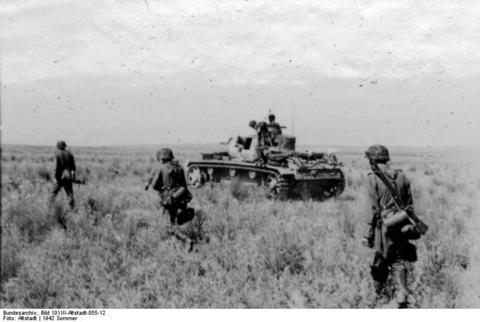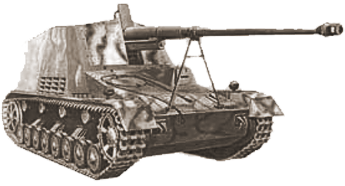Thoughts on Operation Blue's June-July 1942 First Phase

The initial plans for Germany's 1942 summer offensive, code-named "Operation Blue" called for four sequential operations. The first, Blue I, featured the Four Panzer Army, German Second Army, and German Sixth Army all working together to encircle and destroy Soviet forces before the city of Voronezh along the upper Don River. The second part of the campaign, Blue II, called for the German Sixth Army to turn south in hopes of engineering a planned encirclement at Millerovo on the Donets River. The third phase, Blue III, would see Fourth Panzer Army and Sixth Army to meet the 1st Panzer Army encircle remaining Soviet forces, capture Rostov and then the bulk of these forces would advance on Stalingrad on the Volga River. Once Stalingrad was neutralized (but not needing to be taken) the northern shoulder of the campaign would be set. Only after this had been accomplished would Blue IV kick off and the key drive into the Caucuses. At this point Army Group South was to be split into two independent Army Groups. The key one would be Army Group A under Field Marshal Wilhelm List. His forces would be the one's to march into the Caucuses. Meanwhile, Army Group B would already be in place and shielding Army Group A’s northern flank. In this article we shall examine events during Blue I.
The Axis forces gathered for Blue totalled 102 divisions (72 German) with approximately 1,934 tanks and roughly 1,700 aircraft (depending upon the source with most in agreement that roughly 1,200 were operational). Breaking down the primary Axis armies (read: mostly German) by size them ranging in size from the massive Sixth Army (317,896 men) to the 2nd Army (280,482 men), 1st Panzer Army (226,688 men), 11th Army (164,648 men), 17th Army (135,504) and finally the Fourth Panzer Army (85,643 men). In opposition however the Red Army had massed 1,715,000 men, 2,959 tanks, and 16,500 guns and mortars.
There are many takeaways one can draw from these figures. Perhaps most importantly, considering the Fourth Panzer Army's important role in Blue it is somewhat surprising that its size was over a third smaller than the next sized German army in terms of manpower (with the manpower figures here representing the Istsarke of each army). This also highlights how significant the Axis commitment in Libya had become. For at the very moment Blue was beginning Rommel's Panzer Army was charging into Egypt with a German-only-component roughly analagous in size to the Fourth Panzer Army. This is yet another reason it is important to look again when someone brushes off the size of the German forces in North Africa as insignificant in comparison to those deployed on the German Eastern Front. In the summer of 1942 Rommel deployed a command possessing the personnel, tanks, airpower, and logistical backing to have formed a putative "Fifth Panzer Army" deployed with Army Group South - had the German command seen fit to support Blue with the weight of resources its strategic importance demanded.
Operation Blue began at 2:15am on June 28th. Hoth’s Fourth Panzer Army, the German Second Army, and Gustav von Jany's Hungarian Second Army advanced toward Voronezh in conjunction with Paulus’ Sixth Army (with Paulus advance beginning two days later). General Werner Kempf's XXXXVIII Panzerkorps from Fourth Panzer Army led the way. Kempf's Panzerkorps included the 24th Panzer Division, 16th Motorized Infantry Division, and Grossdeutschland Motorized Infantry Division. In addition the 9th and 11th Panzer Divisions as well as the 3rd Motorized Infantry Divisions also played key roles in the initial advance. The terrain was mostly open steppe representing excellent tank country.
From day one things went badly for the Soviet forces and German combined arms teams again proved too much for the Red Army to handle. For example the 11th Panzer Division's primary kampfgruppe was comprised of the 15th Panzer Regiment, a battalion of infantry, a company of engineers, an artillery battery, a 20mm flak battery, and a battery of 88's. The 11th Panzer Division was able to easily forge the Tim River, build up a bridgehead, and take the first day's objectives. Meanwhile, the 24th Panzer Division split the Soviet 13th and 40th Army's while penetrating far enough behind the 40th Army to scatter its headquarters and hinder Soviet command and control. Further south the Sixth Army advanced over 30 kilometers behind the Soviet defensive front on just the first day of its offensive. With German armor rampaging behind Soviet lines it was only a matter of time before the Soviet defenses collapsed. The German armies met on July 2nd behind the bulk of the Briansk and Southwestern Front, destroying the Soviet 40th and 21st armies as well as wrecking four of the Briank Front's seven Tank Corps while leaving the other three in terrible condition all while capturing Voronezh on July 6th. The Germans reported as of July 8th the taking of 73,000 prisoners of war, 1,200 Soviet tanks captured or destroyed as well as 1,200 artillery pieces. In fact, and across the German Eastern Front since May 1st (and thus including German operations in Army Group North and Center's areas) they had destroyed eight Soviet armies, taken 660,500 prisoners of war and inflicted an equally staggering cost to the Red Army in terms of killed, wounded, or missing.
As usual, in spite of suffering heavy losses the Briansk Front and new Voronezh Front had fought hard - effort bolstered by substantial reinforcements that by July 3rd included a reserve army, five independent Tank Corps, the new 5th Tank Army, 23 rifle divisions, and two brigades. But the 5th Tank Army was by far the most powerful of these formations. Led by Generarl A.I. Liziukov, the 5th Tank Army included 641 tanks as well the 5th Tank Army's more famous future commander - General Pavel Romistrov (at this time leading the 7th Tank Corps. Nevertheless, like most of the Soviet formations of that era and their leadership the combat arms both integral to the 5th Tank Army as well its neighboring units simply could not coordinate at anywhere near the German level. With the Luftwaffe owning the skies over the battlefield Hoth’s Fourth Panzer Army made short work of Liziukov's command. By July 15th the 5th Tank Army had lost 341 tanks as destroyed with those knocked out and in repair totalling 158 machines and all tolf from the original 641 tanks deployed. These massive armored losses were matched by the 5th Tank Army's huge casualties reaching 7,929 men. The 16th Tank Corps which had supported the 5th Tank Army had gone from 181 operational tanks to twelve (with 33 in repair) as of July 13th. In contrast, the 11th Panzer Division, which had been heavily involved in the fighting against the powerful Soviet tank reserves, reported the total loss of only fifteen panzers in the first week of Blue.
That said, many of the other German formations had taken a beating. For instance, the 23rd Panzer Division had suffered the total loss of 20 tanks in short order and so many others were in repair that by July 1st it only had 35 left as operational of the 138 tanks it had begun the battle. In addition, the 9th Panzer Division and 82nd Infantry Division had suffered substantial casualties. Though Fleigerkorps VIII had largely dominated the skies, losses had reached 110 machines by July 10th. As Blue eventually stretched on into the fall the failure of the German command to adequately respond and address ongoing shortages of infantry and airpower with otherwise available reserves from other theaters of operation would be one of many important factors deciding the outcome of the campaign's most important battles.
Nevertheless, in Blue's first phase the Axis forces had not only destroyed the cream of the rebuilding Soviet tank arm but the combined Axis forces in the region (the German Second, Sixth, Fourth Panzer and Second Hungarian armies) had ripped a massive 280 mile gap in the Soviet defensive lines. In response Stalin ordered General K.K. Rokossovsky to take command of the Briansk Front, Lieutenant General N.F. Vatutin to take over the Voronezh Front, and demoted Liziukov to a corps commander while the 5th Tank Army was pulled from the front line to refit - a process that would see its component tank crops scattered in the weeks to come. As per the planning for Blue's first phase the second phase began with the German Sixth Army and Fourth Panzer Army turning away from the Voronezh region. This happened even as massive Soviet counterattacks commenced outside Voronezh began. Counter-attacks to be parried by the German Second Army then setting the northwestern edge of what would become Army Group South's shoulder. Meanwhile, Sixth Army and Fourth Panzer Army swept southeast toward Millerovo on the Donets River, and Kalach, on the Don River. In doing so the Fourth Panzer Army and Sixth Army would destroy or decimate the Soviet 9th, 21st, 28th, and 38th Army's from the Southwestern and Southern Fronts, but that is a conversation for another article.



Post new comment